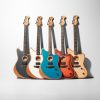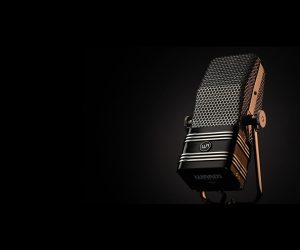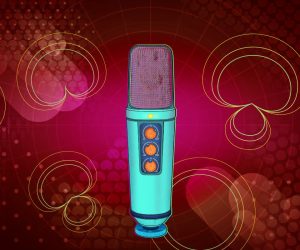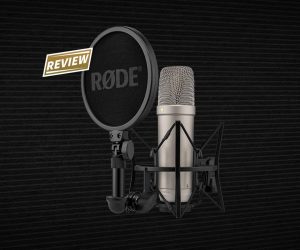
Microphones: Sensitivity
In the fifth instalment of his on-going series about microphones Greg Simmons dives deep into specifications, beginning with Sensitivity – what it means and how it affects your microphone choices...
In the previous installments we looked at how microphones convert sounds into signals. We referred to this as their ‘method of transduction’ and saw that there are two main methods of transduction (‘magnetic induction’ and ‘electrostatic modulation’), which give us the three main families of microphones: ribbons, dynamics and condensers. Each of these methods of converting acoustic energy (sound) into electrical energy (signal) has an impact on the tonality of the captured sound, and each has advantages for some applications and disadvantages for others.
In this installment we move away from the subjective concept of ‘tonality’ that featured so heavily in the previous installments, and towards the objective measurements (aka ‘specifications’) that allow us to compare different microphones and determine which is the best choice for the job. Nobody cares about the lovely warm tonality of your ribbon microphone if the signal is buried in noise, and nobody cares about the crisply detailed tonality of your condenser microphone if the signal is distorting on peaks.
NUMBERS GAME
There are many different microphone specifications and not every manufacturer measures and qualifies them the same way, which means that sometimes they can be hard to compare and sometimes they can’t be compared at all. These deviations from accepted industry standards and norms are often justified with claims that they provide a more ‘realistic’ or more ‘informative’ value. It is pure serendipity that the deviations always seem to provide more impressive-looking numbers while also making it harder to make direct comparisons between competing products.
Specifications are a numbers game, and marketeers have been gaming the numbers for years as they exploit a market that doesn’t understand what those numbers mean. They don’t want you comparing their microphone with their competitors’ microphones – they’ve got you ‘on platform’ and they want to keep you there until you’ve filled your shopping cart. They want you to believe the promise of Eddie ‘Trust Your Ears’ Endorsee when he says “This $200 mic will do everything you want!” rather than the numbers that undeniably state “No it won’t”, because in a sales-driven industry it’s better that you buy 10 wrong mics before you buy that one right mic.
With that in mind, in this installment we begin a deep dive into the numbers that help you find that one right mic without wasting time and money on those 10 wrong mics. We’ll explore the key specifications from a user’s point of view: what they mean, how they’re measured, how they interact, and how they can be compared to help choose the right microphone for the job. We’ll begin with the specifications related to signal level (Sensitivity, Noise, SPL, Dynamic Range and Signal-to-Noise Ratio) and the relationships between them. Considering the number of readers who have already wasted their money on 10 wrong microphones it would be insensitive not to start with Sensitivity, but there’s more to gain by starting with the microphone preamplifier.
GOLDILOCKS & THE dBs
The term ‘gain’ is often used in discussions about microphones and preamplifiers. ‘Gain’ is essentially another word for ‘amplification’; in the context of microphones, it tells us how much amplification is being applied by the preamplifier. If the signal coming out of the preamplifier is 10x bigger than the signal going into it we could say the preamplifier has a gain of 10x. That’s easy to understand, so why is gain always specified in decibels (dB) rather than as a multiplication value?
Microphones create very small signals that require very large amounts of amplification, typically measured in hundreds or even thousands. To avoid writing huge numbers, gain (like many other measurements related to audio signal levels) is usually expressed in decibels. We’ll discuss decibels in detail in a later installment of this series; the important thing to understand for now is that they allow us to use very small numbers to represent very large numbers. For example, the maximum gain on some high quality preamplifiers is +70dB, which is equivalent to x3162. What would you rather see written next to the gain knob on your microphone preamplifier: ‘+70dB’ or ‘x3162’?
The problem with gain is that it brings the noise up with it. Generally speaking, more gain means more noise – although what’s really happening is that the preamplifier is amplifying the noise that comes from its input circuit plus the noise that comes from the microphone, so the more gain you use the more audible the overall noise becomes. [We look further into that when we look at EIN in the ‘Noise 2’ installment of this series…]
Most contemporary microphone preamplifier designs are capable of very low noise performance, but they all exhibit some noise. As the gain is increased this noise reaches a point where it becomes apparent but is still acceptable, e.g. it’s noticeable when solo’d but isn’t noticeable in the mix. Beyond the point of ‘acceptable’, the noise becomes excessive and is considered ‘unacceptable’.
As we’ll see in the forthcoming installments, the noise from the microphone preamplifier is usually only of concern when using passive microphones (passive dynamics and passive ribbons) due to their low Sensitivity and the associated high gain required to reach a useful level. The noise from the microphone preamplifier is not very significant when using active microphones (condensers, active dynamics and active ribbons) because their higher Sensitivity requires less gain, and the noise generated by the microphone itself is considerably higher than the noise from the preamplifier.
In any case, the mic preamplifier on a budget bus-powered interface is likely to reach an unacceptable level of noise at a lower gain setting than it would on an expensive mains-powered rack-mounting microphone preamplifier, simply because it has more noise to start with and therefore requires less gain before its noise becomes audible or objectionable.

Minimising noise from the microphone preamplifier starts by choosing a microphone that can deliver a healthy signal level: high enough that it does not require so much gain from the preamplifier that the noise becomes audible, but not so high that it overloads the input circuit of the microphone preamplifier or downstream devices and causes distortion.
If you’ve got the gain turned all the way down to minimum and still have a high signal level then there’s a risk of distortion; if the sound is not already obviously distorting, it’s possible that the incoming signal level is on the borderline where distortion does not occur during the sound check or rehearsal, but does occur during the excitement of the performance when levels are a dB or so higher.
The right microphone should deliver a signal that puts the preamplifier’s gain into the ‘Goldilocks Zone’; the microphone signal’s level should be high enough to avoid requiring too much gain (thereby making any noise more apparent), but low enough to avoid risking distortion. This brings us to the first microphone specification…
SENSITIVITY
A microphone’s Sensitivity refers to how much voltage (electrical signal) will be present at its output when a known amount of acoustic energy (sound) is present at the diaphragm or ribbon element. If a microphone with a high Sensitivity was placed alongside a microphone with a low Sensitivity and both were focused on the same sound source from the same distance, the higher Sensitivity microphone will give a higher output.

Sensitivity In mV/Pa
Sensitivity is usually specified in ‘mV/Pa’, which means ‘milliVolts per Pascal’. One milliVolt is one thousandth of a Volt (in the same way that a ‘millimetre’ is a thousandth of a metre), and a Volt is a measurement of the amount of electrical pressure contained in the signal that represents the sound. The higher the voltage, the higher the signal level.
A Pascal is a measurement of atmospheric pressure and is used here to represent the sound energy in the air. As a matter of interest, the softest sound that human beings can hear is 0.00002 Pascals (20 microPascals or 20uPa), and is also known as the ‘threshold of audibility’.
One Pascal (1Pa) is equivalent to a Sound Pressure Level (SPL) of 94dB, which is about the same as hearing a steel string acoustic guitar being played at full volume from about 2m away. The table below contains some typical maximum SPLs of numerous musical instruments and distances to provide a point of reference. Note that every doubling of distance causes a 6dB decrease in SPL, and every halving of distance causes a 6dB increase of SPL.
Nobody cares about the lovely warm tonality of your ribbon microphone if the signal is buried in noise...

A 1kHz sine wave tone at a level of 1Pa or 94dB SPL (at the diaphragm or ribbon) is the standard that microphone manufacturers use when measuring Sensitivity, making it easy to compare the Sensitivities of microphones from different manufacturers.
Sensitivity In dBV
Some manufacturers prefer to use a dBV value for Sensitivity, in which case they are specifying it relative to a reference where 0dB = 1Pa = 1V (unless otherwise specified). It should have a ‘V’ at the end to indicate that the reference is 1 Volt, giving us the ‘dBV’ terminology, although some manufacturers neglect to add the ‘V’ which means we cannot be certain what their reference is. They could be intentionally using a lower value than 1V as a reference to create a higher Sensitivity value and we’d never know because that’s how the numbers game works. For now, however, we’ll assume they’re all doing the right thing and using 1V or otherwise specifying their reference…
A Sensitivity value of -20dBV means the microphone’s output voltage is 20dB lower than 0dB, which means it is 20dB lower than 1 Volt, which is 0.1 Volts. How does that work? Read on… (If logarithms and powers of 10 make your eyes glaze over, skip down to the next subheading, ‘Meaningful Sensitivity’.)
For comparison purposes, the following formula converts Sensitivity from dBV into mV/Pa:
mV/Pa = 10(dBV / 20) x 1000
Be sure to include the minus sign when entering the dBV value if the specified Sensitivity value has a minus sign in front of it. Also note that the formula multiplies the answer by 1000 to provide the answer in mV rather than volts.
The next formula reverses the process, converting mV/Pa values into dBV values:
dBV = 20 x log(mV/Pa / 1000)
This formula assumes you are entering the voltage as milliVolts, and divides that value by 1000 to convert it to volts before finding the logarithm.
Let’s check how these formulae work by converting a Sensitivity value from mV/PA to dBV and then back to mV/Pa. We’ll start by converting a Sensitivity of 15mV/Pa to dBV:
dBV = 20 x log(15 / 1000)
dBV = 20 x log(0.015)
dBV = 20 x -1.8239
dBV = -36.48dB
So a Sensitivity of 15mV/Pa is equivalent to -36.48dBV. Let’s check that calculation by going back the other way, hopefully converting -36.48dBV back into 15mV/Pa:
mV/Pa = 10(-36.48 / 20) x 1000
mV/Pa = 10 -1.8239 x 1000
mV/Pa = 0.015 x 1000
mV/Pa = 15mV/Pa
Bingo…
Meaningful Sensitivity
To be meaningful, a Sensitivity specification should be given in mV/Pa or dBV. If it is given in mV/Pa, the ‘Pa’ tells us that 1Pa (one Pascal, equivalent to 94dB SPL) is the reference. If it is given in dBV the ‘V’ tells us that 1 Volt is the reference. In both cases, if we know the reference then we can make meaningful comparisons between specifications from different manufacturers that use the same reference. And, with the help of the formulae above, we can also make comparisons between specifications that quote mV/Pa and those that quote dBV.
Generally speaking, condenser microphones have the highest Sensitivity of all the different microphone types, while passive ribbon microphones have the lowest. Likewise, with all other factors being equal, a larger diaphragm offers higher Sensitivity than a smaller diaphragm (the reasons for this are explained in the next installment, when we look at Self-Noise).
Sensitivity & Mic Choice
So how does Sensitivity influence our choice of microphones? In the tradition of matching the microphone to the sound source, it makes sense to use high Sensitivity mics for soft sounds and low Sensitivity mics for loud sounds. Using a high Sensitivity mic on a soft sound means less gain is required from the preamp, resulting in less noise. Conversely, using a low Sensitivity mic on a loud sound minimises the possibility of distortion due to overloading the preamp or downstream devices. Here are some examples:
Neumann’s U87 large dual-diaphragm condenser is rated at 28mV/Pa in cardioid mode, while their KM184 small single-diaphragm cardioid condenser is rated considerably lower at 15mV/Pa. Audio-Technica’s AT5040 knocks them both out of the park with a whopping 56.2mV/Pa. It’s twice the output of the U87 and almost four times the output of the KM184, and is enough to overload a padless mic preamp when capturing a moderately loud signal. (The later-released premium version of this microphone, the AT5047, offers a lower Sensitivity of 35.5mV/Pa. Despite the addition of an output transformer that could’ve allowed an even higher output, Audio-Technica obviously decided to bring it down a bit.) At the other extreme, DPA’s miniature 4062 has a Sensitivity of 1mV/Pa, which is very low for any microphone but is in keeping with its intended application of being designed for capturing very loud sounds – a situation where low Sensitivity can be an advantage to avoid overloading the preamp and/or downstream devices (this is especially important considering that miniature microphones like the 4062 are often used with portable battery-powered wireless transmitters which can be easily overloaded).
To put these widely varying figures into perspective, if the AT5040, AT5047, U87, KM184 and 4062 were all placed the same distance from the same sound source, the AT5047 would require 3.96dB more gain to match the AT5040’s level, while the U87 would require 6.02dB more gain, the KM184 would require 11.44dB more gain, and the 4062 would require 34.99dB more gain.
If close-miking a snare drum from the edge of the rim, the high output level of the AT5040 would drive some circuits into clipping (even at minimum gain) and the signal would be unusable. Meanwhile the 4062 would require 4.08dB more gain than a Shure SM57 (an industry standard for this application, and therefore a good reference) placed in the same spot. This is not the sort of application that a high Sensitivity mic like the AT5040 is intended for, and a low Sensitivity mic like the 4062 would be a better choice in terms of landing the signal in the Goldilocks Zone – although it’s possible that a hard hit on the snare could exceed the Maximum SPL that either mic can handle without distorting significantly (we’ll explore that problem in a later installment of this series).
What about miking gentle finger-picking on a nylon string guitar from 30cm in front of the point where the neck joins the body? The AT5040 would deliver a signal that most preamps would be happy to work with, while the 4062 would require a preamp with very low noise and high gain to match it. This is not the sort of application that a low Sensitivity microphone like the 4062 is intended for.
Sennheiser’s MD421 II dynamic microphone has a Sensitivity of 2mV/Pa, Electro-Voices’ RE20 comes in at 1.5mV/Pa, and Shure’s SM57 and SM58 both sit at 1.6mV/Pa. If all four mics were placed at the same distance from the same sound source, the RE20 would require 2.5dB more gain to match the MD421, while the SM57 and SM58 would each require 1.94dB more gain. With such small differences between their Sensitivities, all four mics would be equally suitable or equally unsuitable for any given application. From a Sensitivity point of view they’d all be suitable for close-miking a snare drum, but they’d all be unsuitable for miking a gently finger-picked nylon string guitar from 30cm.
Royer’s R121 passive ribbon has a Sensitivity of 4.4mV/Pa, while its active counterpart, the R122, offers 16mV/Pa; that’s an 11.21dB increase in output level, which means 11.21dB less gain is required from the preamp to bring the R122 up to the same signal level as the R121. Similarly, AEA’s R44C (a re-creation of RCA’s classic 44BX) has a Sensitivity of 2.25mV/Pa, while its active counterpart, the A440, offers a higher Sensitivity of 30mV/Pa and therefore requires 22.5dB less gain on the same signal at the same distance. Similarly, the R44C requires 5.83dB more gain to match the R121, while the R122 requires 5.44dB more gain to match the A440.
The R122 and A440 are better choices than the R121 or R44C for capturing finger-picking on a nylon string guitar at 30cm due to their higher Sensitivities, but the opposite would apply for capturing the sound of a Marshall stack pumping out distorted power chords for heavy metal. As far as their Sensitivities are concerned they’d all be good choices for close-miking a snare, but a loud rimshot (the kind of transient ambush that jazz drummers like to sneak in between brush work) might drive some of them into distortion by exceeding their respective Maximum SPL figures, as discussed in a later installment of this series.
SENSITIVITY MATCHING
The three microphone families – ribbons, dynamics and condensers – offer a huge range of Sensitivities covering just about any sound capturing application. Use high Sensitivity microphones for capturing quiet sounds, low Sensitivity mics for capturing loud sounds, and aim to keep your preamplifier’s gain in the Goldilocks Zone. Sounds easy, right? Unfortunately there’s more to it than that because we also have to factor in noise from the microphone and from the preamplifier, which is the subject of the next installment…























You can be a professional singer, a reporter, an interviewer, a karaoke lover, a podcasts maker, and many more. Each of these roles may require a particular kind of gear. Each individual voice can sound different depending on the mic you choose. The problem is often how to make the right choice.
I like your presentation of the material. It helps a lot when it comes to choosing the right equipment!
Thank you Mike! The challenge with stuff like this is trying to keep all the different uses and applications of microphones in mind, as you’ve pointed out above. I’m glad you’re finding it helpful.
Thank you for this!
There’s more coming David!